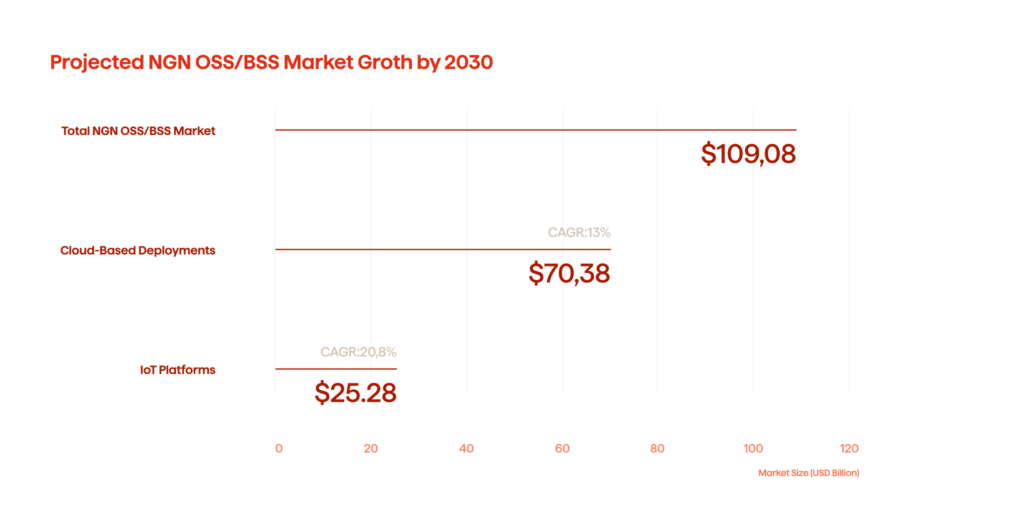The future of OSS/BSS in the modern telco space

June 10, 2025 10 min read
In today’s telecom industry, speed and efficiency alone aren’t enough. Success depends on how well operators manage their infrastructure and monetize their services. That’s where OSS and BSS come into play, and knowing the difference is key. While BSS focuses on customer-facing processes like billing, CRM, and revenue management, OSS covers the operational backbone: service provisioning, network monitoring, and fault management. Both are essential, but they solve very different problems. With the OSS/BSS market projected to grow from USD 68.79 billion in 2024 to USD 78.39 billion in 2025, telcos must make smart decisions about where to modernize first. Should you prioritize improving customer experience and monetization? Or focus on automating service delivery and reducing downtime?
In this article, we unpack the core differences between OSS and BSS, how they interact, and why identifying the right investment path first could determine your competitive edge in the years ahead.
A Business Support System (BSS) vs. An Operation Support System (OSS)
Business support systems (BSS) serve as the digital infrastructure that supports the commercial activities of a telecom operator. It allows telcos to oversee the sale of those services and billing systems, enabling the growth of customers and services provided. An operation support system (OSS) does everything behind the curtain: the network, the performance, and service quality, while also managing the operational capabilities that ensure telecom services are always available to users. They serve as mutually dependent layers in the end-to-end telecom framework, and their integration is critical for the seamless delivery of monetized services at scale.
For instance, when a customer orders a new 5G data plan through a self-service portal (a BSS function), that request must be communicated to OSS in real-time to begin service provisioning, secure network resources, and activate the connection across the appropriate access and core layers. This often includes provisioning through fiber optics infrastructure in fixed networks, ensuring high-speed and reliable connectivity. Real-time synchronization is typically achieved through service orchestration and standardized APIs. Commonly adopted solutions include TM Forum’s Open Digital Architecture (ODA) and standards such as Open APIs and the Shared Information/Data Model (SID), which facilitate OSS/BSS integration and help service providers move beyond legacy silos.
For context and alignment, here’s a high-level summary of OSS and BSS interactions across the telecom service lifecycle.
| Phase | BSS Responsibilities | OSS Responsibilities |
| Product definition | Define product catalog, pricing models | Map services to technical capabilities and network resources |
| Customer onboarding | Order entry, eligibility checks, credit validation | Service provisioning, resource allocation |
| Service activation | Trigger activation workflow | Configure network, activate elements, assign IP, QoS, etc. |
| Ongoing usage | Usage metering, charging, billing | Collect usage data, monitor performance |
| Fault & assurance | Notify users, offer compensation | Fault detection, ticketing, resolution, SLA monitoring |
| Customer care | CRM, helpdesk, plan changes, complaints | Network diagnostics, service validation tools |
The Evolution of OSS and BSS Solutions

The introduction of 5G, IoT, AI, and cloud computing is expected to propel the Next Generation Network (NGN) OSS/BSS market to $109 billion by 2030. With a 13% compound annual growth rate, cloud-based deployments will account for 64.5% of the market. With a 20.8% CAGR, IoT platforms alone will reach $25.2 billion.
These figures indicate more than a surge in demand; they show a significant shift in the way telecom operators design, deploy, and operate their OSS and BSS ecosystems. Historically, OSS and BSS had a strong coupling with legacy, monolithic systems. These systems were typically inflexible, costly to upgrade, and relied heavily on manual processes. Most processes, like billing, resource provisioning, and network configuration, were siloed processes, contributing to long service launches and inefficient network operations. However, as customers’ expectations changed and the telecommunications industry shifted toward digital-first services, telecom operators recognized the need to move beyond the restraints of their legacy systems. The shift began with virtualization, progressed toward software-defined networking (SDN), and is now advancing at high speed into cloud-native architectures.
The emergence of new technologies like microservices, containerization, and orchestration frameworks (like Kubernetes) has allowed operators to move to the continuous deployment model. Instead of waiting months to complete an upgrade cycle, service providers can add features and fixes in weeks, sometimes even days. As networks are increasingly more disaggregated and dynamic, especially concerning 5G network slicing, edge computing, and massive IoT deployments OSS and BSS will become proactive, intelligent platforms. They are not merely back-office tools, but strategic assets that streamline business and customer operations, monetize, and deliver next-generation digital services.
What Spurs the Need for Investment in the Telecom Systems
Modernizing OSS and BSS platforms is crucial for telecom operators looking to remain viable in a hyperconnected, low-latency infrastructure era. However, moving from legacy, monolithic platforms to future-focused, cloud-native stacks presents many different technical and operational challenges.
- Legacy systems entrenchment. Many CSPs still rely on heavily customized, vendor-locked OSS and BSS stacks based on old technologies. These stacks have limited interoperability, extensibility, and compliance with modern frameworks (e.g., TM Forum Open APIs or Open Digital Architecture (ODA)), and ultimately limit the operator’s ability to migrate.
- Integration with heterogeneous environments. Telecom operations are all very complex, including physical network elements (NEs), virtual network functions (VNFs), cloud-native functions (CNFs), and other IT systems in place. Seamless interaction across the layers (i.e., between the BSS, order processing, charging, CRM, OSS, service provisioning, FCAPS) requires integrations focused on service orchestration, real-time mediation, and event-driven architecture.
- Data fragmentation, inconsistent schemas. Customer, service, and network data are often dispersed across siloed systems relying on inconsistent data models. Aggregating everything to a central normalized information model, such as a Shared Information/Data model (i.e., SID), is essential for supporting analytics, closed-loop assurance, and automation using AI/ML.
- Service continuity and downtime risks. Large-scale migrations are often associated with a risk of service degradation or interruptions. Keeping the network active, compliant with SLA (Service Level Agreement), and zero-touch provisioning applicable during staged transitions requires dual-stack operations, blue-green deployment method, and fault-tolerant architecture.
- Skill gaps and DevOps maturity. Next-gen OSS/BSS architectures will rely on microservices architecture, container orchestration (Kubernetes), CI/CD pipelines, and infrastructure as code (IaC). Most Telcos struggle with internal capabilities and maturity for DevOps practices, thereby causing delays in modernization efforts and increased reliance on System Integrators.
- Regulatory compliance and network security. As data dives into hybrid or public cloud architectures, ensuring compliance with residency laws (GDPR, HIPAA) and implementing carrier-grade security (AAA, PKI, network slicing isolation) becomes highly complicated.
The Case for OSS Modernization: Enabling Network Intelligence and Service Assurance
In CSPs, the OSS part of the technical stack represents the control layer governing network operations, resource orchestration, and service assurance. OSS modernization is not just replacing legacy monitoring systems but enabling the intelligent, automated, and scalable management of networks in a multi-technology, software-defined environment.
Modern OSS platforms support service provisioning, real-time performance analytics, fault isolation, and network inventory management across physical infrastructure, virtual network functions (VNFs), and cloud-native functions (CNFs). They also oversee critical infrastructure such as fiber-optic networks, enabling dense urban deployments and last-mile service delivery. With the rise of 5G, IoT, and edge computing dramatically increasing the number of service endpoints and configuration states, OSS forms the foundation for SLA compliance and dynamic service quality. Advanced OSS capabilities leverage AI/ML for predictive fault isolation and self-healing, integrating with SDN controllers to automate configuration across access, transport, and core domains. Combined with real-time telemetry and event correlation, these capabilities enable closed-loop assurance – allowing CSPs to detect and resolve anomalies before they impact service performance.
While OSS transformation has its strategic importance, it’s also complicated. Legacy EMS/NMS platform integration, alignment with TM Forum’s ODA, and development of interoperability layers using open APIs or message buses can span several years. Moreover, the potential operational risk is high: misaligned provisioning logic or misconfigured orchestration flows could easily result in service outages, revenue leakage, or breach of SLAs with customers. The time to engage in OSS-related investments should be when the CSP desires to improve operational intelligence, lower MTTR, or provide zero-touch service provisioning. However, if these OSS gains are not realised in parallel with a BSS uplift, operators will struggle to see these benefits translate into value to the customer or self-billing accuracy in newly provisioned services.
The Case for BSS Modernization: Accelerating Monetization and Digital Engagement
BSS serves as the commercial hub in telecommunications operations. It is often responsible for product lifecycle management, real-time charging, customer lifecycle management (CLM), and partner settlement. If communications service providers wish to compete on the agility of service and service personalization, modernizing BSS is a necessity. Next-gen BSS platforms enable dynamic offer creation, real-time enforcement of policy, and customer interface, taking advantage of digital channels.
A modern BSS stack also enables CSPs to create 5G network slices with differential pricing levels, convergent charging for multi-service bundles, and omnichannel customer engagement management. Open API support integrates with self-care portals, digital marketplace, and 3rd party ecosystems. Additionally, there is value in decoupling monolithic BSS into microservices to enable an agile release cycle using CI/CD pipelines. Business teams are empowered to configure promotions, modify rating rules, and submit partner onboarding requests, all with little involvement from IT. This accelerates time to revenue and responsiveness to emerging market trends.
Despite the potential benefits of BSS transformation, the process carries risk. Legacy billing systems are often heavily customized, with hard-coded business logic, complex mediation flows, and undisclosed dependencies. Transitioning to a cloud-native platform, for example, may create challenges for revenue assurance or inhibit existing integrations with legacy OSS, CRM, or financial systems. Having customers have a consistent view of changes made among customer care, billing, and provisioning systems also remains a typical challenge. While CSPs wanting to grow ARPU, reduce churn, or create new revenue streams such as B2B2X should prioritize BSS modernization, to achieve true end-to-end service delivery and fulfillment, BSS must leverage a modern, programmable OSS layer. BSS modernization is ultimately how strategy meets revenue execution; it changes how telcos socialize their capabilities, but there still needs to be a reliable operational layer underneath to ensure that promises made are promises kept.
Final Thoughts: Future-Ready OSS and BSS Architecture
Amid the ongoing evolution of the telecom industry, there is no longer a choice; effective network management as well as seamless operations for customer management are essential. OSS and BSS might perform different tasks, however, they are most effective when seamlessly integrated.
As operators seek to remain competitive, an investment in future-ready OSS and BSS software development is a must. The core task is to thoroughly consider all the pros and cons of each system and make smart investment decisions accordingly. Want to learn more about the integration of OSS and BSS to simplify your day-to-day operations? Looking for ways to maintain and improve customer relationships? Contact Avenga, your trustworthy expert in effective BSS and OSS systems.



